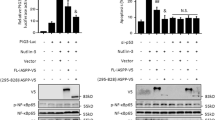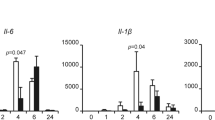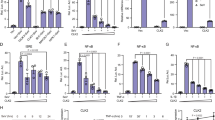Abstract
Nuclear factor-κB (NF-κB) is a dynamic transcription factor that regulates important biological processes involved in cancer initiation and progression. Identifying regulators that control the half-life of NF-κB is important to understanding molecular processes that control the duration of transcriptional responses. In this study we identify copine-I, a calcium phospholipid-binding protein, as a novel repressor that physically interacts with p65 to inhibit NF-κB transcription. Knockdown of copine-I by siRNA increases tumor necrosis factor α-stimulated NF-κB transcription, while copine-I expression blocks endogenous transcription. Copine-I abolishes NF-κB transcription by inducing endoprotease processing of the N-terminus of p65, a process antagonized by IκBα. Copine-I stimulates endoproteolysis of p65 within a conserved region that is required for base-specific contact with DNA. p65 proteins lacking the N-terminus fail to bind to DNA and act as dominant-negative molecules that inhibit NF-κB transcription. Our work provides evidence that copine-I regulates the half-life of NF-κB transcriptional responses through a novel mechanism that involves endoproteolysis of the p65 protein.
This is a preview of subscription content, access via your institution
Access options
Subscribe to this journal
Receive 50 print issues and online access
$259.00 per year
only $5.18 per issue
Buy this article
- Purchase on Springer Link
- Instant access to full article PDF
Prices may be subject to local taxes which are calculated during checkout






Similar content being viewed by others
References
Ashburner BP, Westerheide SD, Baldwin Jr AS . (2001). The p65 (RelA) subunit of NF-κB interacts with the histone deacetylase (HDAC) corepressors HDAC1 and HDAC2 to negatively regulate gene expression. Mol Cell Biol 21: 7065–7077.
Baldwin AS . (1996). The NF-κB and IκBproteins: new discoveries and insights. Annu Rev Immunol 14: 649–681.
Burstein E, Hoberg JE, Wilkinson AS, Rumble JM, Csomos RA, Komarck CM et al. (2005). COMMD proteins, a novel family of structural and functional homologs of MURR1. J Biol Chem 280: 22222–22232.
Chen FE, Huang DB, Chen YQ, Ghosh G . (1998). Crystal structure of p50/p65 heterodimer of transcription factor NF-κB bound to DNA. Nature 391: 410–413.
Chen LF, Fischle W, Verdin E, Greene WC . (2001). Duration of nuclear NF-kappa B action regulated by reversible acetylation. Science 293: 1653–1657.
Chen LF, Williams SA, Mu Y, Nakano H, Duerr JM, Buckbinder L et al. (2005). NF-kappaB RelA phosphorylation regulates RelA acetylation. Mol Cell Biol 25: 7966–7975.
Chen YQ, Ghosh S, Ghosh G . (1998). A novel DNA recognition mode by the NF-kappa B p65 homodimer. Nat Struct Biol 5: 67–73.
Creutz CE, Tomsig JL, Snyder SL, Gautier MC, Skouri F, Beisson J et al. (1998). The copines, a novel class of C2 domain-containing, calcium-dependent, phospholipid-binding proteins conserved from Paramecium to humans. J Biol Chem 273: 1393–1402.
David A, Kacher Y, Specks U, Aviram I . (2003). Interaction of proteinase 3 with CD11b/CD18 (β2integrin) on the cell membrane of human neutrophils. J Leukoc Biol 74: 551–557.
Dickeson SK, Santoro SA . (1998). Ligand recognition by the I domain-containing integrins. Cell Mol Life Sci 54: 556–566.
Fujikawa K, Suzuki H, McMullen B, Chung D . (2001). Purification of human von Willebrand factor-cleaving protease and its identification as a new member of the metalloproteinase family. Blood 98: 1662–1666.
Hayden MS, Ghosh S . (2004). Signaling to NF-κB. Genes Dev 18: 2195–2224.
Hoberg JE, Popko AE, Ramsey CS, Mayo MW . (2006). IκB kinase α-mediated derepression of SMRT potentiates acetylation of RelA/p65 by p300. Mol Cell Biol 26: 457–471.
Hoberg JE, Yeung F, Mayo MW . (2004). SMRT derepression by the IκB kinase α: a prerequisite to NF-κB transcription and survival. Mol Cell 16: 245–255.
Huang E, Cheng SH, Dressman H, Pittman J, Tsou MH, Horng CF et al. (2003). Gene expression predictors of breast cancer outcomes. Lancet 361: 1590–1596.
Huber MA, Azoitei N, Baumann B, Grunert S, Sommer A, Pehamberger H et al. (2004). NF-κB is essential for epithelial-mesenchymal transition and metastasis in a model of breast cancer progression. J Clin Invest 114: 569–581.
Jacobs MD, Harrison SC . (1998). Structure of an IκBá/NF-κB Complex. Cell 95: 749–758.
Kang KH, Lee KH, Kim MY, Choi KH . (2001). Caspase-3-mediated cleavage of the NF-κB subunit p65 at the NH2 terminus potentiates naphthoquinone analog-induced apoptosis. J Biol Chem 276: 24638–24644.
Karin M, Ben Neriah Y . (2000). Phosphorylation meets ubiquitination: the control of NF-κB activity. Annu Rev Immunol 18: 621–663.
Karin M, Greten FR . (2005). NF-κB: linking inflammation and immunity to cancer development and progression. Nat Rev Immunol 5: 749–759.
Kim TM, Jeong HJ, Seo MY, Kim SC, Park KH, Park CH et al. (2005). Determination of genes relative to gastrointestinal tract origin cancers cells using a cDNA microarray. Clin Cancer Res 11: 79–86.
Kurosawa S, Esmon CT, Stearns-Kurosawa DJ . (2000). The soluble endothelial protein C receptor binds to activated neutrophils: involvement of proteinase-3 and CD11b/CD18. J Immunol 165: 4697–4703.
Levkau B, Scatena M, Giachelli CM, Ross R, Raines EW . (1999). Apoptosis overrides survival signals through a caspase-mediated dominant-negative NF-κB loop. Nat Cell Biol 1: 227–233.
Li S, Armstrong CM, Bertin N, Ge H, Milstein S, Boxem M et al. (2004). A map of the interactome network of the metazoan C. elegans. Science 303: 540–543.
Lin L, Ghosh S . (1996). A glycine-rich region in NF-kappaB p105 functions as a processing signal for the generation of the p50 subunit. Mol Cell Biol 16: 2248–2254.
Maine GN, Mao X, Komarck CM, Burstein E . (2007). COMMD1 promotes the ubiquitination of NF-κB subunits through a cullin-containing ubiquitin ligase. EMBO J 26: 436–447.
Maitra R, Grigoryev DN, Kumar Bera T, Pastan IH, Lee B . (2003). Cloning, molecular characterization, and expression analysis of Copine 8. Biochem Biophys Res Commun 303: 842–847.
Mayo MW, Madrid LV, Westerheide SD, Jones DR, Yuan X-J, Baldwin AS et al. (2002). PTEN blocks TNF-induced NF-κB-dependent transcription by inhibiting the transactivation potential of p65 subunit. J Biol Chem 277: 11116–11125.
Nalefski EA, Falke JJ . (1996). The C2 domain calcium-binding motif: structural and functional diversity. Protein Sci 5: 2375–2390.
Phelps CB, Sengchanthalangsy LL, Malek S, Ghosh G . (2000). Mechanism of kappa B DNA binding by Rel/NF-kappa B dimers. J Biol Chem 275: 24392–24399.
Preston GA, Zarella CS, Pendergraft III WF, Rudolph EH, Yang JJ, Sekura SB et al. (2002). Novel effects of neutrophil-derived proteinase 3 and elastase on the vascular endothelium involve in vivo cleavage of NF-κB and proapoptotic changes in JNK, ERK, and p38 MAPK signaling pathways. J Am Soc Nephrol 13: 2840–2849.
Rizo J, Sudhof TC . (1998). C2-domains, structure and function of a universal Ca2+-binding domain. J Biol Chem 273: 15879–15882.
Ruben SM, Narayanan R, Klement JF, Chen CH, Rosen CA . (1992). Functional characterization of the NF-kappa B p65 transcriptional activator and an alternatively spliced derivative. Mol Cell Biol 12: 444–454.
Saccani S, Marazzi I, Beg AA, Natoli G . (2004). Degradation of promoter-bound p65/RelA is essential for the prompt termination of the nuclear factor κB response. J Exp Med 200: 107–113.
Tomsig JL, Creutz CE . (2000). Biochemical characterization of copine: a ubiquitous Ca2+-dependent, phospholipid-binding protein. Biochemistry 39: 16163–16175.
Tomsig JL, Creutz CE . (2002). Copines: a ubiquitous family of Ca2+-dependent phospholipid-binding proteins. Cell and Mol Life Sci 59: 1467–1477.
Tomsig JL, Snyder SL, Creutz CE . (2003). Identification of targets for calcium signaling through the copine family of proteins—characterization of a coiled-coil copine-binding motif. J Biol Chem 278: 10048–10054.
Tomsig JL, Sohma H, Creutz CE . (2004). Calcium-dependent regulation of tumour necrosis factor-α receptor signalling by copine. Biochem J 378: 1089–1094.
Whittaker CA, Hynes RO . (2002). Distribution and evolution of von Willebrand/integrin A domains: widely dispersed domains with roles in cell adhesion and elsewhere. Mol Biol Cell 13: 3369–3387.
Wilson KS, Roberts H, Leek R, Harris AL, Geradts J . (2002). Differential gene expression patterns in HER2/neu- positive and -negative breast cancer cell lines and tissues. Am J Pathol 161: 1171–1185.
Yeung F, Hoberg JE, Ramsey CS, Keller MD, Jones DR, Frye R et al. (2004). Modulation of NF-kappaB-dependent transcription and cell survival by the SIRT1 deacetylase. EMBO J 23: 2369–2380.
Zhong HH, May MJ, Jimi E, Ghosh S . (2002). The phosphorylation status of nuclear NF-κB determines its association with CBP/p300 or HDAC1. Mol Cell 9: 625–636.
Acknowledgements
We thank A Sherman and L Gray for editorial assistance. This work was supported by the National Cancer Institute R01CA095644 and R01CA104397 awarded to MWM and the Department of Defense Idea Development Award PC050549 to MWM and CEC.
Author information
Authors and Affiliations
Corresponding author
Additional information
Supplementary Information accompanies the paper on the Oncogene website (http://www.nature.com/onc).
Rights and permissions
About this article
Cite this article
Ramsey, C., Yeung, F., Stoddard, P. et al. Copine-I represses NF-κB transcription by endoproteolysis of p65. Oncogene 27, 3516–3526 (2008). https://doi.org/10.1038/sj.onc.1211030
Received:
Revised:
Accepted:
Published:
Issue Date:
DOI: https://doi.org/10.1038/sj.onc.1211030
Keywords
This article is cited by
-
Mechanisms of three-dimensional growth of thyroid cells during long-term simulated microgravity
Scientific Reports (2015)
-
Proteins associated with pancreatic cancer survival in patients with resectable pancreatic ductal adenocarcinoma
Laboratory Investigation (2015)
-
Copine1 Enhances Neuronal Differentiation of the Hippocampal Progenitor HiB5 Cells
Molecules and Cells (2012)
-
Co-regulatory expression quantitative trait loci mapping: method and application to endometrial cancer
BMC Medical Genomics (2011)
-
NF-κB addiction and its role in cancer: ‘one size does not fit all’
Oncogene (2011)



